We rolled in to Lençois at 5 AM after a 7 hour bus ride inland from Salvador. As we walked to our hostel, a light rain coated the former mining town, which is situated at the edge of Chapada Diamantina, a diamond mine turned National Park. After a quick nap, we set out under blue skies to find a guide to take us on a 5-day trek into the mountainous, forest-dense park.
Optimistic for our first trek as vagabonders, we never expected that we would return 6 days later under the cover of a dark, cloudy sky, drenched and exhausted after unexpectedly swimming through surging rivers and walking barefoot for 2 hours along a rocky, muddy road with the sounds of unseen animals spurring us to go faster. Here’s how we got there…
__________
This is Puma.
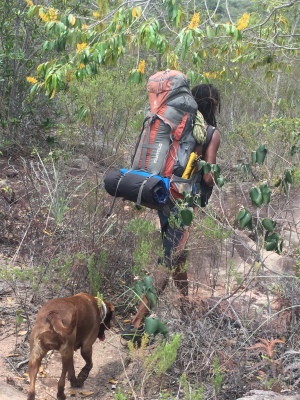
Puma is a 6-year army veteran and Bob Marley-quoting hippie who has bestowed upon himself the nickname “Puma de Adventure” and adheres to the motto, “If you believe, you can.” Behind Puma is Canella. Canella is Puma’s dog and, might we add, the best-trained dog we have ever met (until we meet Oliver, of course).
For our 5-day trek through Chapada Diamantina, Puma and Canella served as our guides as we trekked through mountains and valleys, over rivers and fallen trees and up waterfalls and plateaus.
We decided to shun the formal tour agencies in favor of the accredited Puma after his promise of a “true adventure” (and a customized, individual tour). Unlike most tour companies which offer 5-day treks with 1 night of camping in tents and 3 nights of sleeping in indoor huts along the trails, we soon learned (conveniently after hiring him) that Puma believes in “true nature” – no formal trails, no indoor huts and no tents.
So, after arriving at Puma’s house early in the morning, we packed up our bags with 5-days worth of food and headed out to the waterfall-ridden valleys of Chapada Diamantina. At least our guide proved to be strong, as his bag certainly weighed multiples of ours.
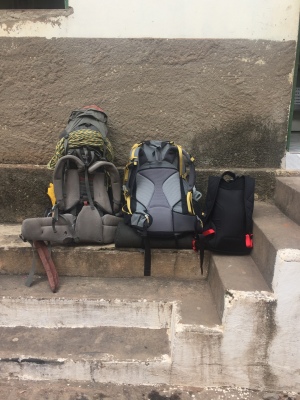
Day 1: “The Day We Realized This is The Real Deal”
We were feeling good after starting our hike trekking up and then back down a mountain and lunching on turkey sandwiches alongside a river under a sunny sky.
However, as we began our descent into the thick, jungle-like valley, the skies started to darken, and Puma quickened our pace in order to make it to our first campsite before rainfall. Soon, we were trekking at a fast-pace over slippery rocks and zig-zagging through a rising river (Alie was soon covered in bruises). We stopped to admire a waterfall, only to have Puma inform us that we would be climbing up it. Now the two of us have done our fair share of hiking, and Michael has bouldered before (well, maybe once or twice), but we had certainly never climbed a vertical waterfall. Somehow, with hearts pounding (and all too often Puma’s strength), we made it to the top, embarrassed by Canella’s ability to manage the climb better than we humans.
We arrived at our campsite that night, and set up camp under the jutting rocks, which easily kept us dry despite a night full of rain.
It was during our first night that we also learned of Puma’s excellent cooking skills – something we came to appreciate each night after a long day of trekking – as he cooked up hearty meals of meat, vegetables, and many forms of tapioca.
Day 2: “The Day We Had to Keep Up”
After Puma chided us in the morning about our slow pace the day before (unwilling to hear our pleas of, “But our packs are so heavy…”), we hurried to keep up with his and Canella’s fast pace on Day 2. After climbing through a slippery valley and over a recently-burned mountainside (a fire had sadly destroyed 17 hectares of the park only weeks before), we arrived at a site that most visitors to Chapada don’t get to see.
Fumaça waterfall cascades 1,115 feet and provides the main draw for hikers coming to Chapada Diamantina. With Puma de Adventure leading the charge, we shunned the typical path taken by guides, which leads to the base and then the top of the waterfall, and instead took the less-worn (and tougher) path to see the waterfall in all its glory (from the side of a cliff).
Afterwards, we traveled to campsite number two, bathed in a waterfall and attempted to sleep on our 2-foot wide rock that Puma allotted us (granted this outcrop, unlike that at our first campsite, wasn’t spacious).
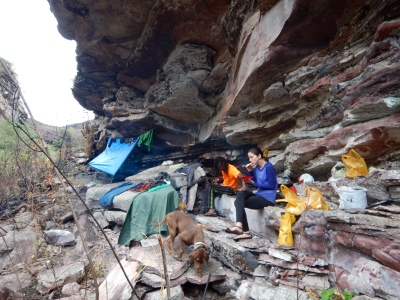
Day 3: “The Day Things Were ‘Easy'”
By easy, we mean that Puma finally took a trail he described as “easier” in order to help us relax a bit after two long days of trekking. We did start the day in a lighter manner, enjoying a swim in a nearby waterfall.
Nonetheless, Puma’s “easy” still had us trekking along mountainsides, hiking barefoot through the jungle and across rocky rivers and scrambling nearly vertical to reach a plateau where things actually did get a bit easier after we came across a former miners’ path, which led to our third campsite.
Before arriving at this campsite, we somehow stumbled along an abandoned tent, which Puma decided to take, providing us with an indoor shelter for the first time in 3 nights.
Day 4: “The Day We Thanked Puma for Taking The Abandoned Tent”
We awoke on the morning of Day 4 to an absolute downpour. With the rain too hard to trek through and the threat imposed by the rising river, we were instructed to hunker down for the day. The positive: we had an indoor shelter. The negative: that shelter was quickly flooding, and we spent from 5 AM to 10:30 AM sitting in said flooded tent, waiting for the rain to stop.
Emerging from our tent after the rain subsided, we noticed that the creek beside our tent that the night before moved so slowly we could bathe in it was now a surging river. Although the sky appeared to clear up, with dark clouds in the distance, Puma decided that we should pack quickly and seek real shelter elsewhere.
Day 4 involved only a quick hike along the (now flooded) miners path, and we spent the rest of the day resting at and exploring the many cave shelters formerly occupied by miners.
Day 5: “The Day of the Flood”
Although the pace of the rain had tempered, water continued to fall from the sky throughout the night and into the morning. Puma, knowing we had 3 rivers to cross in order to make it back to Lençois, encouraged us to take our time as we made our way down the slippery, rocky mountainside in order to a) be safe and b) give the rivers time to subside so we could hopefully cross.
Along the way to the first river, we came across a few locals’ homes that were covered in mangos. Puma decided that this would be the perfect place to rest while waiting for the rivers to lower, and we proceeded to seek shelter with a number of marijuana-smoking locals.
While feasting on mangos, a stranded Austrailian Trekker named Alex, who had been seeking shelter in a local’s house for the past 2 days, emerged. We proceeded to chat with Alex all afternoon as Puma continued to check the level of the river and plot with the locals about what to do (in Portuguese, to our chagrin, as we were left in the dark).
At 6 PM, with the sun starting to set and the river still high, Puma took action and led us to the riverside. He sternly told us to trust him, and ordered Alie to sit in a large bucket with a rope wrapped around it. Puma tossed our bags into the bucket, and instructed Michael and Alex to prepare for a swim. With night falling, we weren’t sure if Puma (a search-and-rescue volunteer in the park) was joking.
After several minutes of intense interrogation between Alie and Puma, and a partial demonstration from the locals, we decided to test the plan. So, Alex, Puma, Michael and a local (attached to Alie’s bucket) dove into the water and swam about the length of a football field to the other side against a strong current.
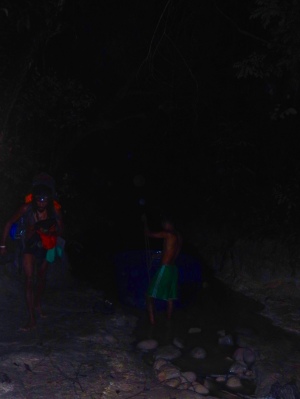
Feeling triumphant, we breathed a sigh of relief. But Puma immediately instructed us to throw on our head lamps and stormed down the muddy, flooded road ahead. Over the next two hours, we stumbled (barefoot) along the path, fighting through several other rivers, slipping on mud and stubbing our toes on any number of rocks. All the while, the increasingly loud sounds of croaks, meows and growls egged us on to move faster. Soaked, exhausted, bruised, and limping, we finally arrived in Lençois 2 hours later.
Needless to say, we spent the next 24 hours resting and gloating in the glory of our survival.
__________
Tessers’ Tips
Things to do:
- Chapada Diamantina is a hikers paradise. You can take single day and multi-day treks (guides required – don’t get stranded like our friend Alex!) throughout the Park. The Park has various terrains. We stuck to the northern region, filled with mountains, jungles and waterfalls and, of course, the Fumaça waterfall. Pati Valley is another popular region, which offers easier hiking atop the plateaus of the valleys. We were told it’s also a beautiful area (clear sky permitting).
- A short walk from town is an area called Ribeirao de Meio with waterfalls and rocks and natural pools – a great area to relax before or after hiking.
- Lençois is also a Hippie town full of music festivals – the week we were there was the Ressonar Festival, a facilitator of art, music, learning, and sustainable living under the first full moon of the year (we have never seen so many hippies and dreadlocks in our lives).
Days Stayed / Recommended: We spent a total of 7 days in the region, bookending our 5 day trek with two days in Lençois. The overnight bus to and from Salvador made this an appealing option. Others in our hostel stayed in the region from 2 days to over a week.
Accommodations: We stayed at Pousada dos Duendes, which offered a friendly, English-speaking staff and a delicious breakfast. It also has its own tour agency, which came in handy as we thought through our trekking options. However, the hostel is a bit of a walk from the central area of town, where you can find plenty of hostels. There are also Eco-lodge / more upscale hotels, such as Pousada Villa Serrano, where we took yoga on our first day.
Local Food: Many, many forms of tapioca (crepe, cream, pudding, crackers, cake…).
Michael’s Sustainable Fun Fact: Drinking water comes directly from the river in Chapada Diamantina. Don’t be put off by its pee-like yellowish, brown color, which is a result of organic material in the Park. We promise, the water tastes great (and no Steripen needed… we still haven’t found a use for it yet and haven’t bought a single water bottle!).
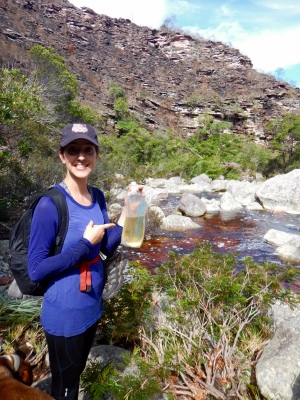


























Chapada Diamantina looks SO beautiful, and it definitely sounds like an adventure to remember, but please be careful! I don’t like the sound of you crossing swollen, rushing rivers in the dark.
Simply gorgeous though.
LikeLiked by 1 person
Loved the waterfall and (hearing about) the adventure…and learned a lot: who knew you could/would ever have to bail out a tent?? Can’t wait for the next installment! xoxo, Cheryl
LikeLiked by 1 person
What is the Mosquito situation ?
And malaria.
We returned from a week in the Amazon jungle with possibly 1000 mosquito bites ea. To our amazement the bites went away after just a few days.
We ended up giving away our malaria pills to the locals.
Uncle Scott
LikeLiked by 1 person
Lots of mosquitos but nothing crazy! Used lots of repellant. The worst part was the poison ivy! No malaria!
LikeLike
Wow….. This was really wild and amazing…. I’m glad to know you made through all of it with a great pack of unforgettable adventures.
I can’t wait until your next destination ! Please be careful and don’t forget to always wear bug repellent.
Big hug still from Punta 🙂
LikeLiked by 1 person
You already have enough “remember the time…” non-embellished stories for a lifetime. Have fun!! x0
LikeLiked by 1 person
I am Melissa Siegel’s grandmother
and am enjoying reading your blog. Of course if I was your grandmother
I would have had a heart attack by now.
Love reading this.
Shirley
LikeLike
Aw thank you Shirley! We have a grandmother Shirley also – she doesn’t read every post though! Don’t worry we are keeping safe. So glad you enjoy following along!
LikeLike
Hi,
How can I get in contact with Puma? I would love to do my trip with him.
LikeLike
Hi Ina! Our recommendation… Go to Pousada dos Duendes and hook a right up that street and call out “Puma! Canella!” Or just go into town and ask around – everyone knows him. We set up our trip with him when we arrived in Lencois for the next day so no need to book in advance – unless he is out on a trek already. We will let you know if we are able to get any better contact information for him!
LikeLike